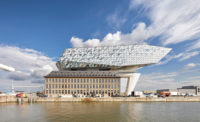Dame Zaha Hadid died a year ago, age 65, on March 31, 2016, in Miami. A symposium at Princeton University on March 30 and 31 marks the first anniversary of her death, bringing together those know knew her, including Patrik Schumacher, her longtime collaborator, and many of her students. “It was a traumatic event,” says Zaha Hadid Architects’ (ZHA) director Gianluca Racana, who has been with the firm 17 years and was instrumental in the design of the MAXXI Museum in Rome. “But in a weird way, it’s been a catalyst for the work of the office and the relationships between the people here. In some ways, it’s similar to what happened after the World Trade Center attack in New York; everyone says that, afterwards, those living in the city felt a greater sense of belonging, togetherness, and identity . . . We feel that, and the pressure to keep up the quality of the work of Zaha and this office moving forward.”
It is rare for a practice to outlive its eponymous founder—Le Corbusier, Mies van der Rohe, Oscar Niemeyer, and Eero Saarinen’s firms are all extinct. However, with Schumacher at the helm, ZHA hopes to prove the exception. “There was some kind of succession plan, in terms of my position,” Schumacher explains. “We had done so much together over the last decades. When I started [in 1988] there were four people here, and now we have 400–we achieved all that together.” Schumacher was the brains behind the practice’s investment in computational processes, which enabled Hadid’s deconstructionist schemes to finally be realized in three dimensions, and he worked on her first completed building, the Vitra Fire Station (1992). He coined the term “parametricism” to describe the resulting fluid, sculptural forms, a theory elaborated in a series of abstruse books and sometimes referred to as “Patrik-metricism” by his boss.
I am meeting with Schumacher in a long and narrow glass-walled room, with views out over the London skyline, in the firm’s offices above the Zaha Hadid Design Gallery on Goswell Road. He is joined by two of the four members of the board of directors, Racana and CEO Mouzhan Majidi. It is tempting to imagine that both are present to keep their principal on message. Over the past year, Schumacher has generated columns of controversy with his free-market libertarian provocations. In 2016, at the Venice Biennale, he criticized the “vacuous, quasi-socialist consensus” that had taken over architecture. And at the World Architecture Festival in Berlin last November his statements about “free-riding” tenants living in social housing were reported in the Guardian and landed Schumacher on the front page of London’s Evening Standard. (The headline: “Storm as Dame Zaha’s Successor Calls for Affordable Housing to be Scrapped.”) Protestors camped outside the firm’s Clerkenwell office chanting, “Stop the fascist!” and even chased Schumacher down the street.
Other members of the practice distanced themselves from Schumacher’s “urban policy pronouncements” in a statement that hinted at disunity, even mutiny. “I bloodied my nose, and I’ve learned my lessons,” Schumacher sighs, before adding, “But also my views aren’t as outrageous as they were made out to be.” Today, the senior figures I meet are very keen to emphasize the “collegial” atmosphere of the firm, “the shared methodology and vision,” where ideas “flow democratically and not hierarchically.” Majidi joined two years ago, after a long stint at Foster + Partners: “This is a lot more like a family,” he says. “At this scale, it feels a lot more intimate and not so corporate.” Even so, the practice has offices in London, New York, Beijing, Hong Kong, Dubai, and Mexico City.
When Hadid died, there were 36 projects on the books, 24 of them already on-site. The last year has seen the completion of a mollusk-like maritime terminal in Salerno, Italy; the crowning of a port building in Antwerp, with a dazzling form reminiscent of the hull of a ship; the fitting of the Mathematics Gallery in the Science Museum with a tensile structure intended to evoke the airflow around an airplane; and a new walnut furniture collection, Interstellar, for David Gill Gallery, both in London. This April, ZHA will open a train station in Naples, and their Manhattan midrise at West 28th Street, next to the High Line, is just topping out.
The firm has a special team devoted to research and competitions, many of whom are Hadid’s and Schumacher’s former students from the Architectural Association. They develop algorithms and tools, and explore new materials and ideas in installations and pavilions. In the firm’s gallery, the Meta-Utopia exhibition showcases new robotic fabrication techniques, a theme also explored in the pavilion ZHA is building for Samsung at this year’s Salone del Mobile in Milan. These innovative principles and forms are expanded in the studio’s competition entries, for which they often only have a few weeks to submit. “We don’t approach each project as a new research,” explains Racana. “We like to see a continuity in our work. The value of this office is the capacity to think outside the box and apply innovative design processes at every scale and typology.”
The firm, well known for its distinctive cultural projects, is increasingly working for corporate clients, and one of the schemes about to break ground is a headquarters for Sberbank in Moscow. This will feature a megaatrium, influenced by the neo-futuristic hotel designs of the Atlanta architect John Portman —a large, dramatic central space with open platforms, under a big shell roof. The trio show me renderings of other projects that are still in the pipeline, which include a huge bridge over the Tamsui River in Taipei, billed as “the world’s largest asymmetric cable-stayed bridge with a single tower”; two tapering skyscrapers with expressive facades in Australia; a mixeduse development with staggered volumes that allow for multiple balconies in Monterrey, Mexico; and the starfish-shaped Beijing airport, which will be the largest passenger terminal in the world and is the practice’s most ambitious project to date.
“We seem to still be credible as candidates for major cultural and other large projects, airports and so on,” Schumacher says. The first post-Zaha competition win was for a 10,000-seat eco-stadium for the Forest Green Rovers (who play in the fifth tier of English soccer), to be built entirely out of timber. They are also in the running for several other projects, including a concert hall in Munich, the National Holocaust Memorial in London (for which they’ve partnered with artist Anish Kapoor), and the National War Museum in New Delhi, a city from which Schumacher has just returned. Not all entries have been successful. Schumacher is still smarting after losing, to Herzog and de Meuron, the commission to extend the New National Gallery in Berlin: it was his love of Mies that enticed him into architecture. Showing me two thick portfolio volumes, he tells me that ZHA is planning an exhibition in its own gallery of these “hundreds of unpublished and unseen projects.”
There was an article in February’s issue of Building Design that reported profits at the practice were significantly down, due to falling workloads in Asia and the Middle East. Majidi points out that these figures referred to accounts filed for the financial year that ended just after Hadid’s death. “I think, in terms of workflow and numbers,” he says, “this year we’ve done more work in terms of revenue than the previous one; it’s probably been one of our best years.” As with every big firm, the challenge is to refresh the order book. “We have to explore the world market in all its corners,” Schumacher adds. “There’s always an economic downturn, and we have to be able to sustain the firm. Australia and Russia are two new lucrative areas for us.” He looks out the window, full of zeal for a parametric future. “In London, we’d like to have things like the Leadenhall Tower or the Shard. We will have things like this in London, Berlin, New York, and Paris. That’s the ambition . . . and that’s what Zaha was also very keen on.”













Post a comment to this article
Report Abusive Comment